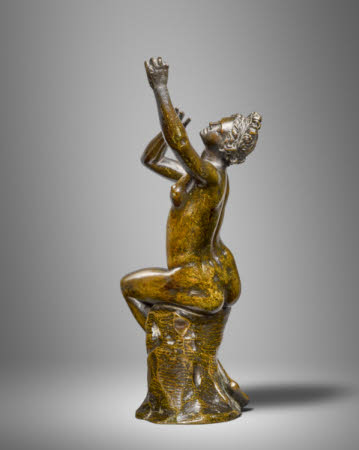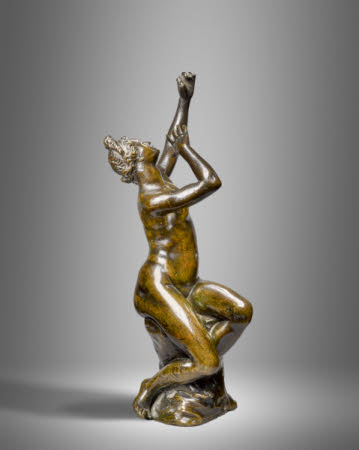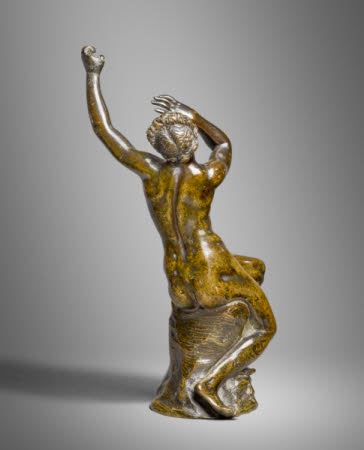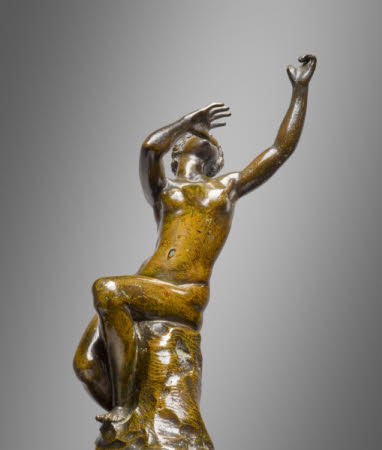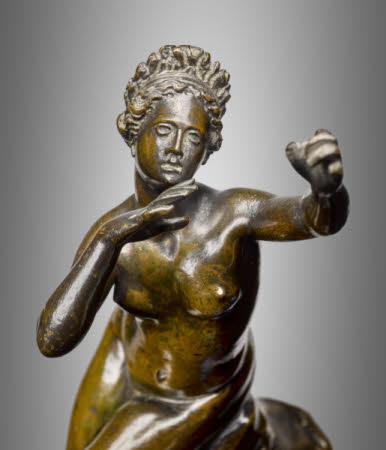A figure of a woman, perhaps Andromeda
attributed to Giambologna (Douai 1529 - Florence 1608)
Category
Art / Sculpture
Date
c. 1580 - 1600
Materials
Bronze
Measurements
143 x 44 mm
Place of origin
Florence
Order this imageCollection
Anglesey Abbey, Cambridgeshire
NT 515068
Summary
Bronze, A figure of a woman, perhaps Andromeda, attributed to Giovanni Bologna (Giambologna, 1529-1608), cast attributed to Antonio Susini (1558-1624), c. 1580-1600. A small bronze figure of a woman, perhaps Andromeda, seated upon a rocky mass or tree trunk, her left knee raised. The woman is naked, and wears in her hair a tiara formed of laurel leaves, held in place with a simple fillet. She twists her body and raises her head and arms up towards her left. The figure is carefully and exquisitely worked. Made in Florence probably c. 1580-1600, cast attributed to Antonio Susini (1558-1624), after a model attributed to Giovanni Bologna (Giambologna, 1529-1608).
Full description
A small figure in bronze of a naked woman, who is seated a little precariously upon a seat, probably of rock but possibly a tree trunk. In the woman’s hair is a tiara formed of laurel leaves, held in place with a simple fillet. Her left knee is raised and she leans backwards, twisting her body and raising her head and arms up towards her left. The figure is carefully and exquisitely worked. There is an iron core pin below left shoulder, others in left waist/buttock and in right shoulder. This exquisite small figure appears to show the young woman beseechingly raising her gaze and her arms. However, her expression does not suggest she is distressed; in reality, there is probably no specific subject, beyond the pleasure the artist has taken in modelling a body formed from a series of sinuous curls rising from the woman’s lower right leg and foot, up through her body and out into her arms. The one other version known, now in the Museo Nazionale del Bargello, Florence (Inv. 67 B), was however described in early inventories of the works of art in the Uffizi galleries as a figure of Andromeda, daughter of the king and queen of the Phoenician kingdom of Ethiopia, who was chained to rocks as a sacrifice to a sea-monster, before her rescue by Perseus. It is not impossible to conceive of Andromeda as the subject of this figure. The figure is exceptionally rare, with the one other version known in the Bargello being a very rough cast. It seems to be first recorded in the Medici collections in 1704- 14, in an inventory of the Uffizi galleries, in which it was recorded (no. 1264) as a figure of Andromeda: ‘An antique bronze figure, depicting Andromeda naked and seated upon a mass’. The model is one of a number of small bronze figures that can be associated with the Flemish-born sculptor Giambologna (Giovanni Bologna, 1529-1608), who spent most of his career working as court sculptor to the Medici in Florence, where he became arguably the most influential sculptor of the entire sixteenth century. Giambologna made monumental masterpieces in marble and bronze, but was also a leading sculptor of the small bronze. Since the most popular models were cast in multiple versions, often for use as diplomatic gifts to be sent to courts throughout Europe, his small bronzes became widely known beyond Florence. Examples of Giambologna models at Anglesey Abbey include a statuette of a bathing woman in a version recorded in the 17th century in the French royal collections (NT 515035), a small gilt bronze figure of a peasant leaning upon his staff (NT 515066) or a figure of a Bull (NT 515077 and 515167). Giambologna delegated almost all the casting and finishing of his small bronze sculptures to trusted assistants and collaborators, notably Antonio Susini (1558-1624) and Pietro Tacca (1577-1640). Only a small number of casts can be associated with Giambologna’s own lifetime. His models continued to be made by Susini, Tacca and their successors in Florence, but also elsewhere in Italy and Europe, over a very long period. Exceptionally well-modelled and beautifully finished, the Anglesey Abbey statuette has a good claim to date from Giambologna’s lifetime and to have been made from a model by him, probably by Antonio Susini, who was a famously skilled finisher of bronzes. In 1605 Giambologna wrote that Susini’s casts of his models were ‘among the best things that can be had from my hands’ (letter of 6 August 1605 from Giambologna to Belisario Vinta). It can be related to other elegant small-scale figures, notably a standing woman bathing and a crouching woman, who kneels and looks upwards, raising her left hand in a gesture of surprise or fear (Charles Avery and Anthony Radcliffe, eds., Giambologna 1529-1608. Sculptor to the Medici, London 1978, nos. 5-6, 21-22). These and other models reflect the studies of ancient sculptures that Giambologna is known to have undertaken, when he was living as a young man in Rome in the 1550s. Both the little crouching woman looking upwards and the Anglesey Abbey figure would appear to be based on a famous ancient sculpture of the crouching Venus by the Greek sculptor Doidalses, but which was known through later Roman marble copies. Giambologna used the antique model to develop his own independent models, in the small crouching woman, beginning to open out and twist the torso of the woman. In the Anglesey Abbey statuette this process is taken still further, the torsion more extreme and the body a little slimmer and more consciously elegant. The Anglesey Abbey figure may in turn be related to figures of struggling women that form key elements in some of Giambologna’s most famous models, the Abduction of the Sabine Woman (a late copy at Arlington Court, NT 985341.1) and Nessus and Deianira, in which the centaur Nessus attempts to carry off Hercules’ wife Deianira. In all these models, a consistent and highly emotive motif is the woman’s twisting of her body and head and the throwing of one arm high into the air, precisely the same gesture as in the Anglesey Abbey figure, except that she raises both arms. It seems therefore that this beautiful model, an exquisite study in the human form, may also have played its part in the development of one of Giambologna’s most expressive female figures. Jeremy Warren October 2021
Provenance
Bequeathed to the National Trust by Huttleston Rogers Broughton, 1st Lord Fairhaven (1896-1966) with the house and the rest of the contents.
Credit line
Anglesey Abbey, The Fairhaven Collection (The National Trust)
Makers and roles
attributed to Giambologna (Douai 1529 - Florence 1608), sculptor attributed to Antonio Susini (fl.Florence 1572 – d.Florence 1624), caster previously catalogued as by Italian School or Flemish School, sculptor
References
Christie, Manson & Woods 1971: The National Trust, Anglesey Abbey, Cambridge. Inventory: Furniture, Textiles, Porcelain, Bronzes, Sculpture and Garden Ornaments’, 1971, p. 138. Warren 2021a: Jeremy Warren, 'Giambologna's 'Andromeda': a new model?', The Burlington Magazine, Vol. 163 (November 2021), pp. 1010-19.

